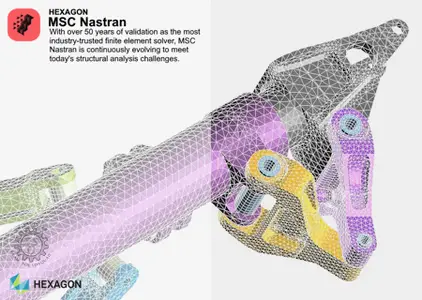
Free Download MSC Nastran 2024.1 | 13.8 Gb
Hexagon is proud to announce the release of MSC Nastran 2024.1. This new version of MSC Nastran brings revolutionary capabilities for nonlinear solutions with SOL 400, high-performance computing improvements, enhanced rotordynamics, and powerful new NVH analysis tools. For complete MSC Nastran workflows, the recent release of MSC Apex 2024.1 offers more comprehensive support of MSC Nastran than ever before
Owner:MSC Software
Product Name:MSC Nastran
Version:2024.1
Supported Architectures:x64
Website Home Page :
hexagon.com/
Languages Supported:english
System Requirements:Windows & Linux *
Size:13.8 Gb
.
MSC Nastran 2024.1 Release Highlights
New Capabilities
– Automatic Multi-level Reduction (AMSR): A brand-new unique method for static reductions for external superelements and external modules results in up to 10x faster speeds without compromising accuracy
– Symmetry constraints in topometry optimisation
– A new high-performance nonlinear solver in SOL 400 (NLPERF):
. Performance improvements: New DMAP flow, MUMPS solver, and parallel scaling up to 32 cores
. Convergence monitoring for tracking the job status, iteration file (.itr) and GUI monitor
. Friction convergence check in node-to-segment contact, arc-length method in contact problems
Performance and Speed
– Out-of-core (OOC) capability and Distributed Memory Parallel (DMP) options for the MUMPS solver
– Reduce disk space requirements and achieve faster solution times for models with poroelastic materials (PEM) using compressed Reduced Impedance Matrices (RIM)
– Reduce runtimes for linear static problems with a large number of load cases
Enhanced User Experience
– Easy job setup and submission for Transfer Path Analysis (TPA) using the new Single-Step TPA capability
– Model glue lines using cohesive elements in linear solution sequences to easily perform linear analyses of complex nonlinear models
– SOL 128 post-processing improvements include the ability to output iterative outputs for displacements and nonlinear loads in CSV format as well as the ability to obtain outputs for selected output frequencies
Usability and solution Enhancements
– External superelements and residual vectors are now supported in real coupled modes with improved performance
– Append results to existing hdf5 files to allow for tracing and grouping of multiple runs of each modular component through a single file
– The MDSET case control command allows you to select specific modules for data recovery when there are duplicate elements or grid IDs across modules
– The PEAKOUT capability is extended for Equivalent Radiated Power (ERP) at peak frequencies
– Include fluid modes for acoustic grids in the modal neutral file (.mnf) to facilitate to recover acoustic pressure directly in Adams
– Include rotodynamic effects in the modal neutral file (.mnf) to capture rotodynamic effects in Adams
– New enhanced job summary in the .log file
New Capabilities
MSC Nastran 2024.1 brings a wealth of new capabilities including an innovative method for static reductions of external superelements denoted the Automatic Multi-level Reduction (AMSR) method. This method can be utilized to statically reduce external superelements without compromising accuracy while it speeds up the simulation by up to 10 times. In addition, symmetry constraints in topometry optimization are introduced. By exploiting symmetry, engineers can reduce the computational burden by analysing only a portion of the entire structure, essentially solving one segment of the model and then replicating the results across their sym
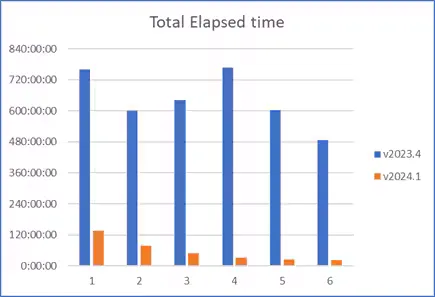
Close
Performance improvements using ASMR
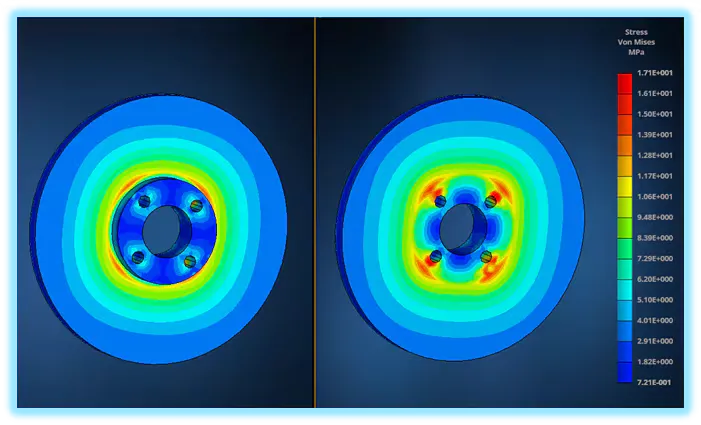
Close
Symmetry Constraints in Topometry Optimization SOL 200
MSC Nastran 2024.1 is the first release of the new high-performance nonlinear solver (NLPERF). In this first release, a performance-based revamp of the SOL 400 architecture is made available. The scope of this release is limited to NLSTATIC but supports all 3D model-space elements of SOL 400, all materials, and all contact features. The new DMAP flow reduces input/output (I/O) operations and leverages SMP performance. MUMPS solver is available for up to 32+ cores. As part of the high-performance nonlinear solver in MSC Nastran v2024.1, additional convergence monitoring features are noteworthy. A dedicated convergence messaging file called the iteration file (.itr) is written which can provide at a glance the status of iterations, increments, and convergence criteria status. A GUI-based monitor is available for the ITR file which continually updates as the analysis proceeds. Furthermore, in node-to-segment (N2S) contact problems when using the high-performance nonlinear solver in MSC Nastran v2024.1, an additional friction convergence check is considered. The tolerance is a ratio of the total friction force change in the iteration to the total friction force on the contact body. Finally, the arc-length convergence methods have been enabled for jobs involving general contact.
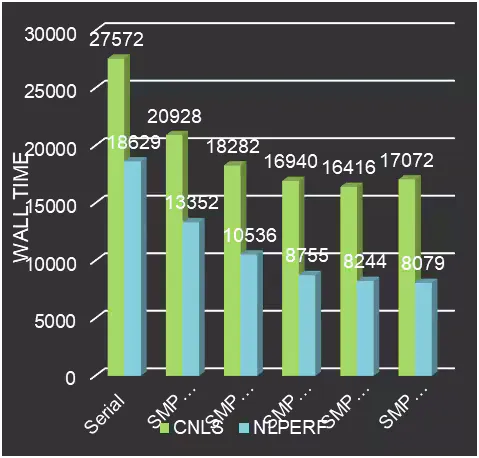
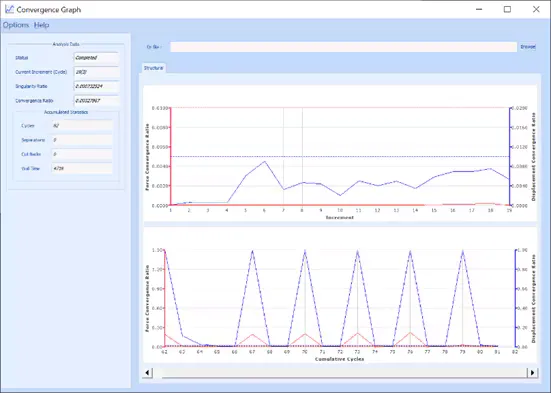
Close
Performance Improvements and convergence monitor in SOL 400 (NLPERF)
Performance and Speed
The MUMPS solver has been expanded to support distributed memory parallel (DMP) operations and can operate out-of-core (OOC), ensuring that jobs can run on nodes with limited capacity.
Version 2024.1 introduces a pioneering technique for compressing reduced impedance matrices in modal approach simulations of poroelastic materials (PEM) within MSC Nastran. This marks a significant performance enhancement, accelerating PEM analysis while reducing disk usage and I/O operations. Consequently, users can now conduct PEM analysis on nodes with restricted resources more efficiently.

Close
PEM Model used for compressed RIM analysis
Furthermore, this release optimises internal MSC Nastran modules dedicated to calculating minimum and maximum output quantities as well as epsilon values, thus significantly boosting performance for users when doing static analyses.
Enhanced User Experience
In this release, the process of determining the key transfer paths from the source to responses, such as tyre excitation to a driver’s ear sound pressure level, typically conducted through two separate frequency response analysis runs (SOL 111), has been streamlined. This enhancement integrates the two separate simulations into a single, faster, and more efficient workflow called single-step TPA, thereby reducing complexity and eliminating the necessity of conducting a separate analysis.
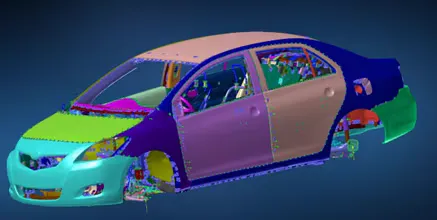
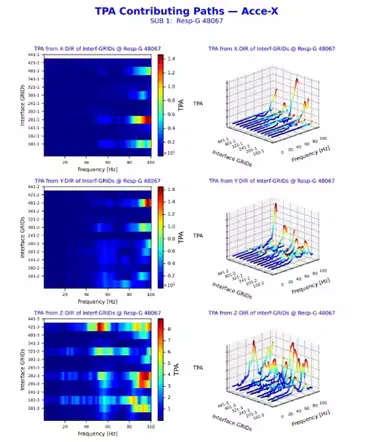
Close
Single Step TPA Analysi
In MSC Nastran 2024.1, nonlinear cohesive elements, typically utilized in crash-type analyses, are now available in linear solution sequences, streamlining interdisciplinary coordination between crash and noise and vibration (NVH) simulations by allowing complex nonlinear analysis to be brought into linear analysis without changes to the modelling methodology.
Finally, SOL 128 rotordynamics has now new enhanced post-processing capabilities to provide displacements and non-linear loads for specific grid-dof pairs at the end of each iteration in a .csv file format. Furthermore, the users can now select a frequency range to get the desired outputs at the end of a fully converged solution.
Usability and Solution Enhancements
Real coupled modes is a method in MSC Nastran used to study the dynamic behaviour or coupled systems accounting for fluid-structure interactions for heavy fluids. In this version, we are extending the capability to support external superelements and we are introducing a new residual vector computation method to improve the accuracy of the modal dynamic analysis. These improvements result in a 3x speedup for external superelement generation run with coupled modes in normal modes run (SOL 103).
MSC Nastran modules are standalone bulk data sections representing parts of a larger assembly, such as a car wheel, or an aircraft’s wing. They simplify the assembly process by allowing multiple components to be combined into a single input file without worrying about conflicting IDs. In v2024.1, a new MDSET entry is introduced to solve the problem of data recovery on modules with overlapping IDs. The user has the option to extract specific results for each module, without replicating the same results on modules that might contain the same grid IDs.
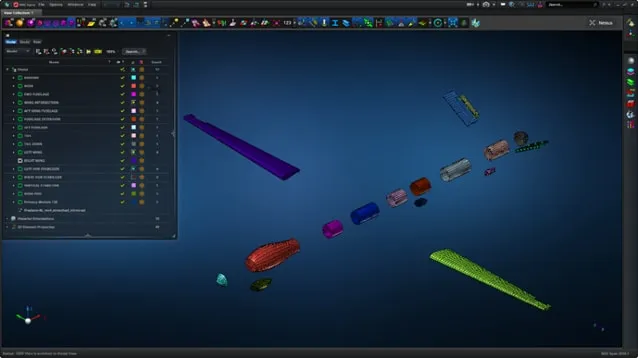
Close
Furthermore, this release brings a new way to organize and store results to an hdf5 file for MSC Nastran Modules. Users can now individually append new results to existing hdf5 files for each module, yielding multiple appended hdf5 files for downstream processing and analysis, enhancing modularity and flexibility.
In this release, the PEAKOUT functionality is also enhanced. The PEAKOUT capability is an automatic way to detect response peaks in frequency response functions and extract additional results at the peak frequencies. Equivalent Radiated Power (ERP) results are now supported in conjunction with PEAKOUT, which has also been enhanced for better performance, stability and robustness.
The modal neutral files (.mnf) capabilities for Adams are also extended. MSC Nastran 2024.1 now supports the direct recovery of acoustic pressure in Adams without requiring restart runs. This enhancement eliminates manual setup with multi-step processes when predicting sound pressure levels in Adams simulations. The Adams post-processor enables the recovery and Descriptionting of acoustic pressure at locations of interest after performing an Adams transient analysis.
In MSC Nastran 2024.1, users can export an Adams .mnf file (SOL 107) containing the rotor dynamic matrices enabling Adams to capture the local effects of the flexible rotors undergoing high-speed rotations more efficiently. Activating rotordynamic computations is necessary during the Adams flexible body calculations. The Campbell diagrams for rotating flexible bodies can be Descriptionted in the Adams post-processor.
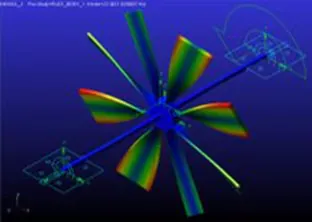
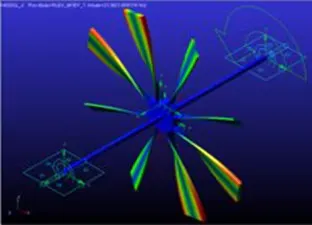
Close
Local twisting of the blades in a rotordynamics analysis
Finally, in MSC Nastran 2024.1 a major usability enhancement was added. All the key information regarding a single run is summarized in the .log file. The users can now find key model solution data in a single location without the need to scan the additional (f06, f04) files.
MSC Nastranis a multidisciplinary structural analysis solver that performs static, dynamic, and thermal analysis across the linear and nonlinear domains, complemented with automated structural optimisation and award-winning embedded fatigue analysis. MSC Nastran is based on sophisticated numerical methods, the most prominent being the Finite Element Method. Solve Nonlinear FE problems with built-in implicit numerical techniques. Get better results with optimisation algorithms, including MSCADS and IPOPT. Perform advanced fatigue and durability analysis in MSC Nastran with built-in CAEfatigue, the fastest and most robust fatigue solution on the market today.
What’s new in MSC Nastran 2024.1
The newest version of MSC Nastran delivers robust multiphysics engineering simulation and finite element analysis (FEA) software, accessible to all engineering analysts for modelling complex systems and components. The recent release of MSC Apex 2024.1 also provides comprehensive support for MSC Nastran, making it a one-stop shop for MSC Nastran pre- and post-processing.
Hexagonis a global leader in sensor, software and autonomous solutions. We are putting data to work to boost efficiency, productivity, and quality across industrial, manufacturing, infrastructure, safety, and mobility applications. Our technologies are shaping urban and production ecosystems to become increasingly connected and autonomous – ensuring a scalable, sustainable future.MSC Software, part of Hexagon’s Manufacturing Intelligence division, is one of the ten original software companies and a global leader in helping product manufacturers to advance their engineering methods with simulation software and services.

Rapidgator
peeplink.in/bf53887b8a2d
Fileaxa
Linux64
x1ff8.MSC.Nastran.2024.1.Linux64-SSQ.part1.rar
x1ff8.MSC.Nastran.2024.1.Linux64-SSQ.part2.rar
x1ff8.MSC.Nastran.2024.1.Linux64-SSQ.part3.rar
x1ff8.MSC.Nastran.2024.1.Linux64-SSQ.part4.rar
Win64
x1ff8.MSC.Nastran.2024.1.Win64-SSQ.part1.rar
x1ff8.MSC.Nastran.2024.1.Win64-SSQ.part2.rar
x1ff8.MSC.Nastran.2024.1.Win64-SSQ.part3.rar
x1ff8.MSC.Nastran.2024.1.Win64-SSQ.part4.rar
TakeFile
Linux64
x1ff8.MSC.Nastran.2024.1.Linux64-SSQ.part1.rar.html
x1ff8.MSC.Nastran.2024.1.Linux64-SSQ.part2.rar.html
x1ff8.MSC.Nastran.2024.1.Linux64-SSQ.part3.rar.html
x1ff8.MSC.Nastran.2024.1.Linux64-SSQ.part4.rar.html
x1ff8.MSC.Nastran.2024.1.Win64-SSQ.part1.rar.html
x1ff8.MSC.Nastran.2024.1.Win64-SSQ.part2.rar.html
x1ff8.MSC.Nastran.2024.1.Win64-SSQ.part3.rar.html
x1ff8.MSC.Nastran.2024.1.Win64-SSQ.part4.rar.html
Fikper
Linux64
x1ff8.MSC.Nastran.2024.1.Linux64-SSQ.part1.rar.html
x1ff8.MSC.Nastran.2024.1.Linux64-SSQ.part2.rar.html
x1ff8.MSC.Nastran.2024.1.Linux64-SSQ.part3.rar.html
x1ff8.MSC.Nastran.2024.1.Linux64-SSQ.part4.rar.html
Win64
x1ff8.MSC.Nastran.2024.1.Win64-SSQ.part1.rar.html
x1ff8.MSC.Nastran.2024.1.Win64-SSQ.part2.rar.html
x1ff8.MSC.Nastran.2024.1.Win64-SSQ.part3.rar.html
x1ff8.MSC.Nastran.2024.1.Win64-SSQ.part4.rar.html










Leave a Reply
You must be logged in to post a comment.